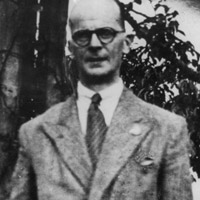John Christie (serial killer)
John Reginald Halliday Christie (8 April 1899 – 15 July 1953) was an English serial killer and necrophile active during the 1940s and early 1950s. He was responsible for the murders of at least eight women, including his wife, Ethel Christie. His crimes were committed at his residence, 10 Rillington Place, Notting Hill, London.
Early Life[edit | edit source]
Christie was born in Northowram, West Riding of Yorkshire, England. He was the sixth of seven children in his family. His father, Ernest John Christie, was a carpet designer, and his mother, Mary Hannah Halliday, was a housewife. Christie had a troubled childhood, marked by a difficult relationship with his father and a domineering mother.
Military Service[edit | edit source]
During World War I, Christie served as a signalman in the British Army. He was injured in a gas attack, which left him with a hysterical muteness for three years. After the war, he worked in various jobs, including as a postman and a cinema projectionist.
Criminal Activities[edit | edit source]
Christie's criminal activities began with petty theft and fraud. However, his crimes escalated significantly in the 1940s. He lured women to his flat under the pretense of providing them with medical treatment, using his knowledge of pharmacology to render them unconscious before strangling them.
Murders[edit | edit source]
Christie's first known victim was Ruth Fuerst, whom he murdered in 1943. Over the next decade, he killed at least seven more women, including Beryl Evans and her daughter, Geraldine Evans. These murders led to the wrongful conviction and execution of Timothy Evans, Beryl's husband, which later became a significant miscarriage of justice case in the UK.
Capture and Trial[edit | edit source]
Christie was arrested on 31 March 1953, after the bodies of his victims were discovered in his flat. He was tried for the murder of his wife, Ethel, and was found guilty. Christie was sentenced to death and was executed by hanging on 15 July 1953 at HM Prison Pentonville.
Legacy[edit | edit source]
The case of John Christie had a profound impact on the British legal system, contributing to the abolition of the death penalty in the UK. The wrongful execution of Timothy Evans led to widespread public outcry and significant changes in the investigation and prosecution of criminal cases.
In Popular Culture[edit | edit source]
Christie's life and crimes have been the subject of numerous books, films, and television series. The most notable adaptation is the 1971 film 10 Rillington Place, in which Richard Attenborough portrayed Christie.
See Also[edit | edit source]
References[edit | edit source]
External Links[edit | edit source]
Search WikiMD
Ad.Tired of being Overweight? Try W8MD's physician weight loss program.
Semaglutide (Ozempic / Wegovy and Tirzepatide (Mounjaro / Zepbound) available.
Advertise on WikiMD
|
WikiMD's Wellness Encyclopedia |
| Let Food Be Thy Medicine Medicine Thy Food - Hippocrates |
Translate this page: - East Asian
中文,
日本,
한국어,
South Asian
हिन्दी,
தமிழ்,
తెలుగు,
Urdu,
ಕನ್ನಡ,
Southeast Asian
Indonesian,
Vietnamese,
Thai,
မြန်မာဘာသာ,
বাংলা
European
español,
Deutsch,
français,
Greek,
português do Brasil,
polski,
română,
русский,
Nederlands,
norsk,
svenska,
suomi,
Italian
Middle Eastern & African
عربى,
Turkish,
Persian,
Hebrew,
Afrikaans,
isiZulu,
Kiswahili,
Other
Bulgarian,
Hungarian,
Czech,
Swedish,
മലയാളം,
मराठी,
ਪੰਜਾਬੀ,
ગુજરાતી,
Portuguese,
Ukrainian
Medical Disclaimer: WikiMD is not a substitute for professional medical advice. The information on WikiMD is provided as an information resource only, may be incorrect, outdated or misleading, and is not to be used or relied on for any diagnostic or treatment purposes. Please consult your health care provider before making any healthcare decisions or for guidance about a specific medical condition. WikiMD expressly disclaims responsibility, and shall have no liability, for any damages, loss, injury, or liability whatsoever suffered as a result of your reliance on the information contained in this site. By visiting this site you agree to the foregoing terms and conditions, which may from time to time be changed or supplemented by WikiMD. If you do not agree to the foregoing terms and conditions, you should not enter or use this site. See full disclaimer.
Credits:Most images are courtesy of Wikimedia commons, and templates Wikipedia, licensed under CC BY SA or similar.
- 1899 births
- 1953 deaths
- 20th-century English criminals
- British Army personnel of World War I
- English people convicted of murder
- English serial killers
- People executed by England and Wales by hanging
- People from Northowram
- People with antisocial personality disorder
- Violence against women in the United Kingdom
- Encyclopedia
Contributors: Prab R. Tumpati, MD

